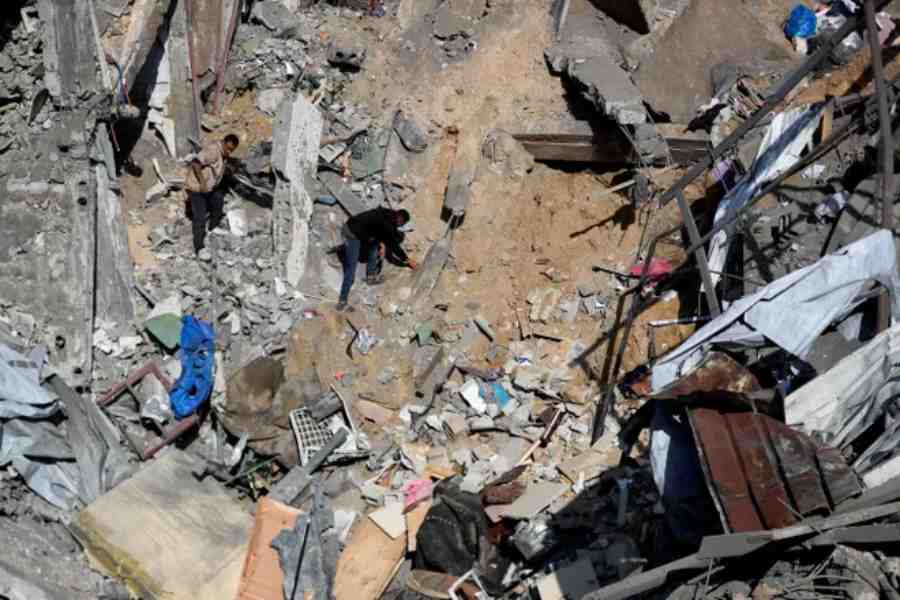Israeli airstrikes in Gaza have killed at least 200 people, according to the Gaza Health Ministry, marking a sharp escalation in hostilities after weeks of ceasefire negotiations collapsed. The strikes, which targeted dozens of locations early Tuesday, shattered a fragile truce that had briefly halted fighting since January. The Israeli military confirmed it had conducted a large-scale operation across multiple areas, including northern Gaza, Gaza City, and the central and southern regions of Deir al-Balah, Khan Younis, and Rafah.
Palestinian health officials reported that many of the casualties were children. Hospitals, already overwhelmed after 15 months of relentless bombardment, are struggling to manage the influx of the dead and wounded. Bodies wrapped in blood-stained white plastic sheets lined hospital floors as medical teams fought to provide care with dwindling resources. The Palestinian Red Crescent reported handling 86 bodies and treating 134 injured individuals, while many more victims were transported by private vehicles due to overcrowding. Officials from Nasser Hospital in Khan Younis, Al-Aqsa Hospital in central Gaza, and Al-Ahly Hospital in Gaza City reported receiving at least 85 deceased victims. Reports confirmed that an airstrike in Rafah claimed the lives of 16 members of a single family.
A spokesperson for the Gaza Health Ministry stated that the total death toll had surpassed 200. Hamas accused Israel of violating the ceasefire agreement, raising concerns over the fate of 59 hostages still held in Gaza. In response, Israeli Prime Minister Benjamin Netanyahu’s office blamed Hamas for the renewed violence, accusing the group of repeatedly refusing to release the remaining hostages despite mediation efforts. “Israel will now act against Hamas with increasing military strength,” Netanyahu’s office declared in a statement.
In Washington, the White House confirmed that Israel had consulted the U.S. administration before launching the strikes. A spokesperson stated that the Israeli military targeted mid-level Hamas commanders, senior leadership figures, and key infrastructure. “Hamas could have extended the ceasefire by releasing hostages but instead chose refusal and war,” said White House spokesperson Brian Hughes. As the airstrikes intensified, Israeli tanks also shelled Rafah, forcing families who had returned home after the ceasefire to flee once again. Witnesses reported waves of civilians moving northward toward Khan Younis, fearing further escalation.
Mediators from Egypt and Qatar had been engaged in weeks of intense negotiations between Israel and Hamas, attempting to extend the truce. Under the initial ceasefire, Hamas released 33 Israeli hostages and five Thai nationals in exchange for approximately 2,000 Palestinian prisoners. Israel, with backing from the United States, sought a longer-term ceasefire in return for the release of the remaining 59 hostages. This proposed extension would have kept the truce in place until after the Muslim fasting month of Ramadan and the Jewish Passover holiday in April.
Hamas, however, insisted on broader negotiations to secure a permanent end to the war and the complete withdrawal of Israeli forces from Gaza. “We demand that the mediators hold Netanyahu and the Zionist occupation fully responsible for violating and overturning the agreement,” Hamas said in a statement. Each side accused the other of failing to uphold the terms of the January truce, leading to multiple interruptions during its implementation. Despite ongoing tensions, both parties had avoided a full-scale return to combat—until now.
Israel had repeatedly blocked aid deliveries to Gaza and threatened to resume military operations if Hamas did not agree to release the remaining hostages. On Tuesday, the Israeli military refrained from disclosing specific details about the strikes, but Palestinian health authorities and witnesses reported widespread destruction across the region. A multi-story building in Gaza City was hit, and at least three homes were destroyed in Deir al-Balah. Further strikes targeted locations in Khan Younis and Rafah. Among those killed was senior Hamas official Mohammad Al-Jmasi, a member of the group’s political office. Hamas sources and relatives confirmed that Al-Jmasi and several of his family members, including his grandchildren, perished when their home was struck. At least five other senior Hamas leaders and their relatives were also killed in the attacks.
Gaza remains devastated after more than 15 months of war, which began on October 7, 2023, when thousands of Hamas-led gunmen carried out a surprise attack on Israeli communities near the Gaza border. The attack resulted in the deaths of approximately 1,200 Israelis and the abduction of 251 hostages, according to Israeli reports. In response, Israel launched an intense military campaign that has killed over 48,000 Palestinians, according to Gaza health officials, and destroyed much of the enclave’s infrastructure, including hospitals, residential buildings, and essential services.
The humanitarian crisis in Gaza has reached catastrophic levels, with international aid organizations warning that food, water, and medical supplies are running dangerously low. Thousands of displaced families are living in makeshift shelters or the ruins of bombed-out buildings. As global pressure mounts for a diplomatic resolution, the resumption of hostilities signals an uncertain and bleak future for civilians trapped in the conflict.
With Israel vowing to continue its military offensive and Hamas refusing to concede, the cycle of violence appears far from over. The international community faces mounting pressure to intervene, but whether a new ceasefire can be negotiated remains uncertain. As airstrikes continue and the death toll rises, the people of Gaza brace for further devastation, while Israeli forces prepare for what could be the next phase in an escalating and bloody conflict.

